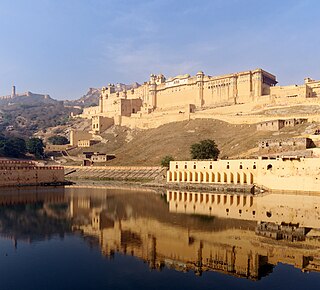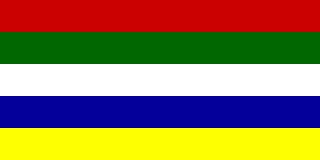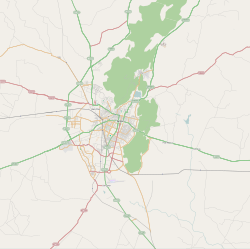
Amber or Amer, is a city near Jaipur city in Jaipur district in the Indian state of Rajasthan. It is now a part of the Jaipur Municipal Corporation.

Alwar is a city located in India's National Capital Region and the administrative headquarters of Alwar District in the state of Rajasthan. It is located 150 km south of Delhi and 150 km north of Jaipur.

Shekhawati is a semi-arid historical region located in the northeast part of Rajasthan, India. The region was ruled by Shekhawat Rajputs. Shekhawati is located in North Rajasthan, comprising the districts of Jhunjhunu, Sikar, Churu and Jaipur. It is bounded on the northwest by the Bikaner region, on the northeast by Haryana, on the east by Mewat, on the southeast by Dhundhar, on the south by Ajmer, and on the southwest by the Marwar region. Its area is 13784 square kilometers.

The Kachhwaha is a Suryavanshi Kshatriya Rajput clan found primarily in India. Sometimes families within the clan ruled a number of kingdoms and princely states, such as Jaipur, Bihar, Uttar Pradesh, Madhya Pradesh, Alwar and Maihar.

Amer Fort or Amber Fort is a fort located in Amer, Rajasthan, India. Amer is a town with an area of 4 square kilometres (1.5 sq mi) located 11 kilometres (6.8 mi) from Jaipur, the capital of Rajasthan. The town of Amer and the Amber Fort were originally built by Raja Man Singh and additions were, later, made by Sawai Jai Singh. Located high on a hill, it is the principal tourist attraction in Jaipur. Amer Fort is known for its artistic style elements. With its large ramparts and series of gates and cobbled paths, the fort overlooks Maota Lake, which is the main source of water for the Amer Palace.

Man Singh I, popularly known as Mirza Raja Man Singh was the 29th Kachwaha Rajput Raja of Amer, later known as Jaipur state, in Rajputana. He was the most powerful and trusted general of the Mughal emperor Akbar, who included him among the Navaratnas, or the nine (nava) gems (ratna) of the royal court of Akbar. Man Singh fought sixty-seven important battles in Kabul, Balkh, Bukhara, Bengal and Central and Southern India. He was well versed in the battle tactics of both the Rajputs as well as the Mughals.

Alwar is a district in the state of Rajasthan in northern India, whose district headquarters is Alwar city. The district covers 8,380 km2. It is bound on the north by Rewari district of Haryana, on the east by Bharatpur district of Rajasthan and Nuh district of Haryana, on the south by Dausa district, and on the west by Jaipur district.

Major General Maharaja Sawai Man Singh II GCSI GCIE was an Indian prince, government official, diplomat and sportsman.
Deogarh, also known as Devgarh, is a town and a municipality in Rajsamand District in the Indian state of Rajasthan. Formerly the town was an estate of the Chundawat Rajputs.

Jaipur State was a princely state in India during East India Company rule and thereafter under the British Raj. It signed a treaty creating a subsidiary alliance with the Company in 1818. It acceded to independent India in 1947 and was integrated into India by 1949. Upon integration, the ruler was granted a pension, certain privileges, and the use of the title Maharaja of Jaipur by the Government of India. However, the pension, privileges, and the use of the title were ended in 1971 by the 26th Amendment to the Constitution of India.
Raja Bharmal, also known as Bihari Mal, Bhagmal and Bihar Mal, was a Rajput ruler of Amer, which was later known as Jaipur, in the present-day Rajasthan state of India.
Kotharia is a town in Rajsamand district of Rajasthan, which was the headquarters of the former 1st class jagir (estate) of the House of Kotharia, part of the Udaipur (Mewar) state, which was in Mewar Residency in Rajputana Agency.
Devi Garh Palace is a heritage hotel and resort, housed in the 18th-century Devi Garh palace in the village of Delwara. It was the royal residence of the rulers of Delwara principality, from mid-18th century till mid-20th century. Situated amidst in the Aravalli hills, 28 km northeast of Udaipur, Rajasthan, Devigarh forms one of the three main passes into the valley of Udaipur.

Alwar State is a princely state with its capital at Alwar in India.
Askaran was a sixteenth-century Rajput monarch. Though briefly Raja of Amber, for the majority of his life Askaran was the ruler of Narwar. He also had a distinguished career as a military officer under the Mughal emperor Akbar and rose high in his service. He was also the maternal grandfather of Mani bai, consort of Emperor Jahangir and mother of Emperor Shah Jahan.
Mundru is an old historical village in Sri Madhopur tehsil of Sikar district of Rajasthan, India.
Prithviraj Singh I, also known as Prithvi Singh I, was a 16th-century Rajput ruler of Amber. He was a monarch of strong religious inclinations and during his reign, Amber became increasingly politically active. He took part in the Rajput alliance against the Mughal emperor Babur, fighting against the latter in the Battle of Khanwa alongside Rana Sanga of Mewar in 1527. Three of Prithviraj's sons successively followed him as ruler of Amber, with many of his descendants also populating the kingdom's highest aristocracy in subsequent centuries.
Puranmal was a sixteenth-century ruler of Amber.
Bhim Singh was a sixteenth-century Rajput ruler of Amber.
Delwara (देलवाडा), nestled in the Aravalli Range (अरावली) hills, is a samll town about 28 kms away from Udaipur, Mewar and close to Eklingji Temple, on way to temple town of Nathdwara, in the state of Rajasthan, India. Delwara was originally known as ‘Devkul Patan Nagri’, which means the town of god. It boasted of over 1500 temples at one time, out of which there were over 400 Jain temples. Delwara was the center of learning and culture before 15th century AD. Around middle of the13th century, Raja Sagar, a Deora Chauhan and a descendant of Rao Kirtipal of Jalore was a very brave king of Delwara (Mewar). Descendants of Raja Sagar sacrificed their lives whilst fighting alongside Ranas of Mewar against Muslim invaders. Raja Sagar was the progenitor of Bachhawat and Bothra clan of Oswals. Sagar's son, Kunwar Bohitya was immensely influenced and inspired by Jain philosophy. Samdhar, a grandson of Bohitya and a Deora Chauhan, was the first man in his genealogy to convert to Jainism.














